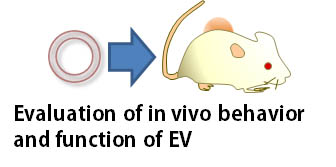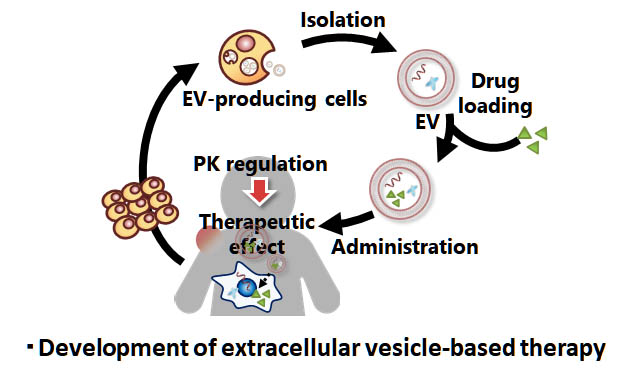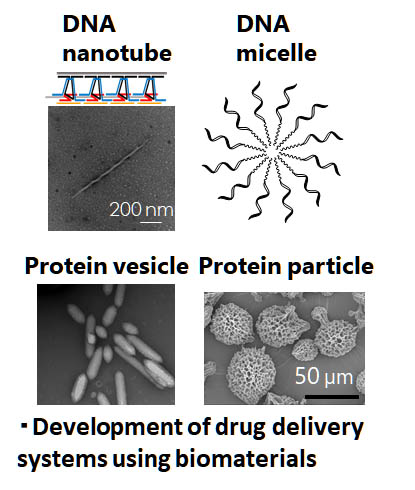ResearchOutline of Teaching Activities
Outline of Research Activities
1)Elucidation of the physiological functions of extracellular vesicles:  Extracellular vesicles (EVs), membrane vesicles secreted by cells, function as intercellular transporter for proteins, DNA and RNA. EVs have been shown to be involved in diseases such as cancer, allergy, and central nervous system diseases, as well as in the maintenance of development and homeostasis in living organisms such as development, differentiation, immunity, and aging. We have been studying the physiological functions of EVs by focusing on their in vivo behavior. So far, we have clarified the factors that determine the behavior of EVs in the body. In addition, we have clarified the role of EVs in cancer, and the mechanism determining the amount of EVs in vivo. Representative articles Matsumoto A, Takahashi Y, Chang HY, Wu YW, Yamamoto A, Ishihama Y, Takakura Y. Blood concentrations of small extracellular vesicles are determined by a balance between abundant secretion and rapid clearance. J Extracell Vesicles. 2019; 9(1): 1696517. PMID: 31807238 Imai T, Takahashi Y, Nishikawa M, Kato K, Morishita M, Yamashita T, Matsumoto A, Charoenviriyakul C, Takakura Y. Macrophage-dependent clearance of systemically administered B16BL6-derived exosomes from the blood circulation in mice. J Extracell Vesicles. 2015;4:26238. PMID: 25669322 2)Development of extracellular vesicle-based therapy:  EVs, which are endogenous material transport carriers, are useful delivery systems for endogenous molecules such as nucleic acids and proteins, and are expected to be used as therapeutic treatment. We are working on the optimization of EV production and isolation methods, the loading of drugs into EVs, the development of methods to control the pharmacokinetics of EVs and the development of EV-based therapies using these methods. We have reported on EV production and isolation methods and drug loading methods suitable for the EV-based therapy. Furthermore, we have developed a strategy to control the pharmacokinetics of EVs and succeeded in developing a cancer vaccine therapy based on the strategy. Representative articles Matsumoto A, Takahashi Y, Ariizumi R, Nishikawa M, Takakura Y. Development of DNA-anchored assembly of small extracellular vesicle for efficient antigen delivery to antigen presenting cells. Biomaterials. 2019; 225: 119518. PMID: 31586864 Morishita M, Takahashi Y, Matsumoto A, Nishikawa M, Takakura Y. Exosome-based tumor antigens-adjuvant co-delivery utilizing genetically engineered tumor cell-derived exosomes with immunostimulatory CpG DNA. Biomaterials. 2016, 111, 55-65. PMID: 27723556 3)Development of drug delivery systems using biomaterials:  Proteins and nucleic acids such as DNA and RNA are biomaterials that have high biocompatibility and can provide various functions by designing their sequences. We are developing drug delivery systems utilizing these biomaterials. We have reported that nucleic acid nanostructures prepared by utilizing the ability of DNA and RNA to form complementary strands can be effective delivery systems. In addition to the development of nucleic acid-based delivery carriers, we are currently investigating the development of protein-based delivery systems. |